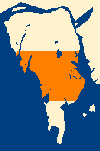 The Northern Suburbs
A large Indian middle class developed in the aftermath of the cotton boom. They were not allowed to build houses in the European districts of Byculla and Breach Candy, nor were they willing to live in the crowded inner city. They created the suburbs of Mumbai starting from the late 19th century. The first scheme for developing housing in the northern parts of Bombay was due to Jamsetji Tata. In the 1890's he had purchased land on Madh Island, Juhu, Bandra and the island of Salsette. During the plague epidemics of the late 1890's he drew up plans for building houses in Salsette. The scheme started in 1896, and the Collector of Thana immediately imposed a punitive levy of Rs. 1,500 per house. This was much larger than the levy in Bombay. In 1899 Tata, on behalf of the residents, appealed to the Governor of Bombay, and later to the viceroy, to no avail. In the meanwhile he pressed ahead with other development plans. He wanted to reclaim land around the Mahim Creek, extending the causeway from Bandra to Santa Cruz. In 1903 this scheme was turned down by the Governor of Bombay. Another of his plans was to develop 1200 acres in Juhu Tara. This would yield 500 plots of one acre each and a seaside resort. Due to his death in 1903 these plans were not pursued further. Soon after, in 1907 the Governor's council proposed a plan to develop Trombay Island; but it had to be abandoned due to lack of interest. Seven years later, in 1913, the BMC set up a committee to develop plans for the opening up of Salsette. There was now sufficient interest for this plan to be viable. In 1916 a municipal council for Ghatkopar-Kirol was set up. In 1918 the city limits were expanded upto Kurla. In 1921 municipal councils were set up in Borivli, Kandivli and Malad. Panchayats were set up in the villages of Malwani, Manori, Goregaon and Bhandup. These were called "Notified Areas". The Western Trunk Route, previously connecting Bandra and Ghodbunder, was extended to Jogeshwari. To the east, the Sion-Trombay road was improved and the new railway line connecting Kurla to Chembur was extended to Mankhurd. 4000 building plans were sanctioned in 1921, including 2500 in Kurla-Kirol, Trombay, Chembur, Donda, Khar, Andheri, Ambarnath and Chapel Road in Bandra. By the 1930's the opening up of Bandra, Santa Cruz, Vile Parle, Andheri, Malad, Borivli and Ghatkopar was complete. These together formed the "Suburban District", with a Collector in charge. About 250,000 people now lived in this district. The developments took the form of small towns containing bungalows and rows of houses. The bungalows of Pali Hill, Versova and Vile Parle were well known for their aesthetic appeal. In fact, a part of Versova is still called Saat Bangla after seven long-vanished bungalows. By 1933 all these areas had their own local authorities. In the late 1930's the municipalities of Bandra and Vile Parle had absorbed several of the smaller bodies. The other areas then came under "Notified Area Committees", with the exception of Versova, which had a "Sanitary Board". Juhu, Versova, Marve and Madh became recreational centres with the richer parts of Bombay building weekend cottages and bungalows for motoring, bathing and sports.
|